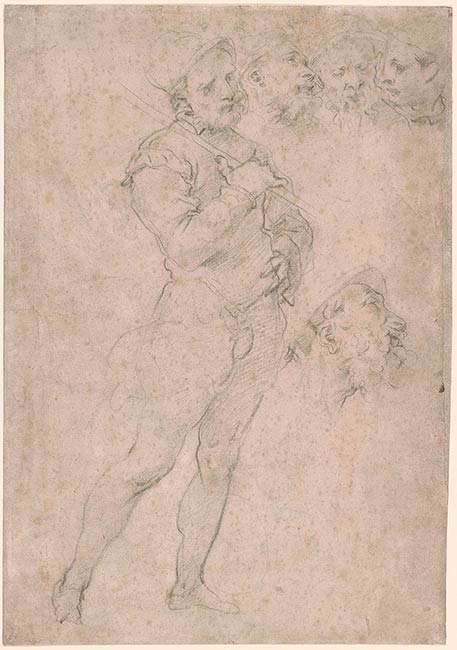

All the studies on the boldly drawn, double-sided sheet Standing Man Holding a Pike are closely related to Vasari’s work at Palazzo Vecchio, a connection first noted by Larry Feinberg in 1991.1 In his subsequent research on Vasari’s drawings, Florian Härb more precisely identified the sketches as studies for the group of halberdiers led by a drummer in the background at upper right of the fresco Emperor Maximilian Ending the Siege of Livorno in the Salone dei Cinquecento.2 Also known as the Sala Grande, the Salone dei Cinquecento, the largest hall built by civic commission in Italy, was decorated at Cosimo I de’ Medici’s behest with grand scenes glorifying Medici deeds and military victories. Härb links the figure and the study of a leg on the verso of the sheet with the standard bearer directly behind the drummer, by whom the standard bearer is partly obscured. The figure of the halberdier and the three heads at upper right on the recto are studies for the group of four soldiers furthest to the left in the same company. The profile head looking up, further down on the same sheet, is a reprise of the third head from the right in the row above, but now turned slightly more away from the viewer than the other attempt.
Vasari often worked in pen and brown ink, and chalk studies such as the present example are comparatively rare. The few extant drawings in this medium indicate that the artist favored black chalk for precise, finished figure studies, as in this instance. The studies on the present sheet suggest that the artist was working from life, using a single, bearded model for almost all the sketches of differently positioned heads. The more generically conceived face of a young man at the far right of the lineup and the figure on the verso were likely developed from other prototypes.
Attributed to Alessandro Allori at the time of the Richter sale in 1913, the drawing was first published as by Giorgio Vasari in the 1985 Sotheby’s sale catalog.3
Footnotes:
- Oberlin and Elsewhere 1991-92, 192, no. 53.
- Gnann and Widauer 2000, 149, 154, note 14; Härb 2015, 465, no. 298.
- Frederik Muller and Cie., Amsterdam, 27-28 May 1913, lot 267; Sotheby’s, New York, 16 January 1985, lot 14.
Florian Härb (written communication and forthcoming catalogue of Vasari drawings) has pointed out that the studies on the recto and verso are not related to the Sala di Leone X of the Palazzo Vecchio, as proposed by Larry Feinberg (From Studio to Studiolo, exhibition catalog), but rather are preparatory to the fresco Emperior Maximilian Ending the Siege of Livorno in the Sala Grande of the Palazzo Vecchio. The drawing can therefore be precisely dated, with a high degree of certainty, to the first half of 1566.
Attributed to Alessandro Allori at the time of the Richter sale in 1913, the drawing was first published as by Giorgio Vasari in the 1985 Sotheby's sale catalogue.
Allori, Alessandro, 1535-1607, Formerly attributed to.
Johnson, Richard, -approximately 1877, former owner.
Richter, John Paul, 1847-1937, former owner.
Seibel, Elmar W., former owner.
Kasper, former owner.
Selected references: Oberlin and Elsewhere 1991-92, 192, no. 53; Gnann and Widauer 2000, 149, 154, note 14; New York 2011, no. 19; Arezzo 2011, 144-147, no. 30; Härb 2015, 465, no. 298.
Larry J. Feinberg, From Studio to Studiolo: Florentine Draftsmanship under the First Medici Grand Dukes, exh. cat., Allen Memorial Art Museum, Oberlin College, Bowdoin College Museum of Art, and Hood Museum of Art, Dartmouth College, 1991-92, no. 53, repr.
